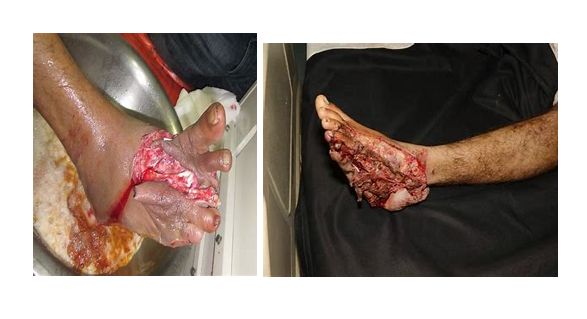What is a foot crush injury?
A foot crush injury is a severe type of broken foot condition. In this injury, the foot is compressed between two hard surfaces, resulting in a “crushing” of bones, soft tissue, and nerves. This often occurs in transportation or occupational accidents, such as if a heavy object falls on the foot, if the foot is run over by heavy machinery, or if the individual is in a car accident.
Foot crush injuries are often more extensive than typical foot breaks. These injuries are typically very severe, including several broken bones and soft tissue damage. As a result, treating a foot crush injury can be exceptionally difficult, often involving podiatrists, orthopedic surgeons, and physical therapists. While minor crush injuries, such as those that do not involve bone fractures, can heal on their own. This condition responds well to quick treatment.

What are the symptoms with foot injury and trauma?
While a foot crush injury may sound like an easy condition to diagnose, doctor will need to identify several symptoms before providing a definitive diagnosis. Each accident and injury cause is different, which means there is wide variety of symptom experiences. The most common foot crush injury symptoms are:
If the injury is left untreated, there are several, more severe symptoms patient may experience.
This can include any of the following.
If you experience any of the above symptoms, even if they are not especially severe, you should consult orthopedic doctor. Compartment syndrome has a delayed presentation, and most foot crush injury symptoms will only become more dangerous and severe with time.
What are the different types of foot crush injuries?
Foot crush injuries follow a certain classification system. Using a very thorough physical exam and history review, the doctor will assess the severity of the injury. This part of the diagnosis is important, as foot crush injuries are very serious, sometimes leading to potential for intensive surgery or amputation. In understanding the type of force applied to the foot, the doctor can better determine the type of injury you have. The different types of foot crush injuries are listed below.
Type I – This type of foot crush injury occurs when the crushing object is heavy and large and has contact with the foot for a long period of time. This causes a gradual tissue and/or bone crush, and the soft tissues may eventually burst.
Type II – This type involves the experience described above, but lacerations are present, causing a mangling of tissues. This is most often associated with open or compound fractures.
Type III – This type of foot crush injury is shear, often involving a degloving from a tangential type force. It typically occurs when the top layers of skin and tissue are ripped from underlying muscle, the connective tissue, or bone. This is often life-threatening.
What is the treatment for crush injuries of the foot?
The foot crush injury treatment depend on the type, severity, location, and cause of the condition. The most minor crush injuries, such as those that result from dropping moderately heavy objects, like books, should be able to heal on their own. In these cases, only superficial soft tissue is damaged, and that damage is extremely minor, often resulting in a bruise. Ice and compression should help to minimize any swelling and pain. Still, you should see a doctor to understand the extent of the injury.
If your foot crush injury has excessive swelling, pain, or bleeding, you will need to see a doctor for treatment. The physician will perform a physical examination and take X-rays to check for fractured bones. Using this information, the doctor will determine your treatment options. This can include a range of casts and splints.
In the least severe cases, some broken bones in the foot can be treated with crutches and flat-bottom shoes. When combined with close monitoring, this can allow the foot to heal on its own. If the broken bones are not aligned, your doctor may need to realign them. This may result in the need for a fiberglass or plaster cast.
In severe cases, foot reconstruction surgery will be recommended, especially if there are several bone breaks and extensive soft tissue injury. In the most extreme cases, the doctor may recommend amputation, but this is only an option if the foot is mangled beyond repair.
If your doctor suspects you have compartment syndrome, or if your foot crush injury puts you at a higher risk for development, your doctor will not place a cast, splint, or anything that causes more pressure. In all cases, it is important to remember that crush injuries should be inspected by a doctor as soon as possible. Time is an important factor in treating a foot crush inju


